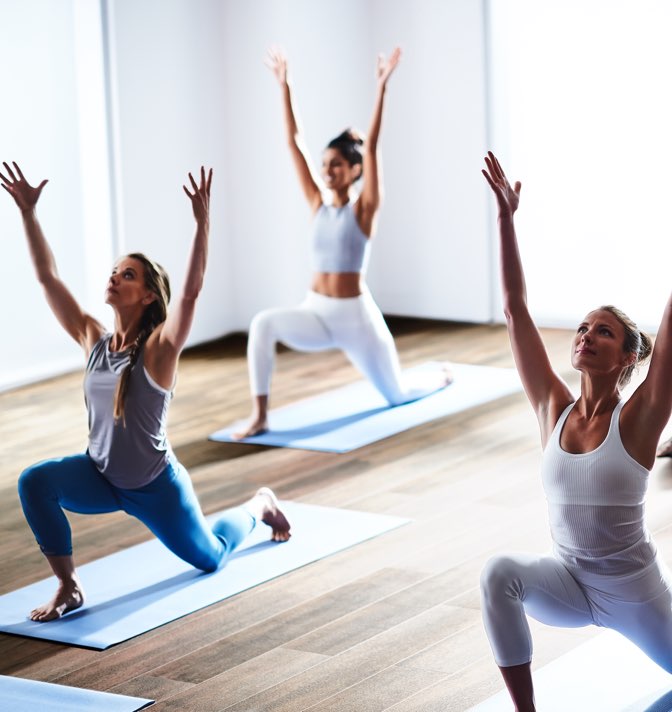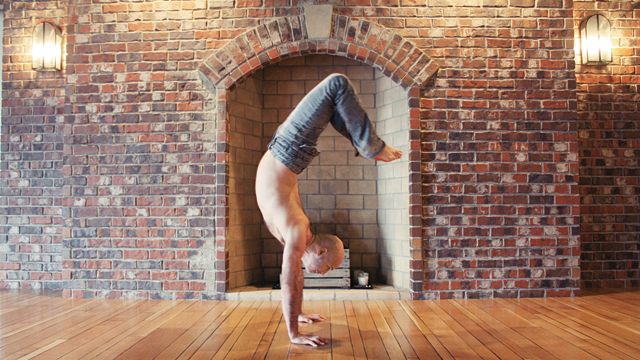Tom Seabourne is a fitness specimen. He’s a two-time national champion in tae kwon do who can chop cinder blocks in half and bench 275 pounds; he also once pedaled 458 miles nonstop in the “Ironbutt” 24-hour bicycle race.
His secret weapon: his mind. For Seabourne, the mind-body connection is many things – a way to summon a powerful punch, concentrate on the ball during a tennis game or free himself from worry in order to relax.
“Mind-body connection leads to discipline,” says Seabourne, PhD, author of Mind/Body Fitness: Focus, Preparation, Performance. “Once you get that discipline, your performance will really begin to skyrocket. Being able to focus gives you a base that can enhance any aspect of your life.”
Clearly, millions of people are discovering the same thing. Mind-body fitness is one of the hottest trends in the exercise industry. About 25 million Americans practiced mind-body exercises like yoga, tai chi and Pilates in 2005, according to a 2006 study by the Sporting Goods Manufacturers Association; many others are exploring activities like qigong and belly dancing. Increasingly, these classes are being offered at places beyond fitness centers, including hospitals, resorts, schools and senior homes.
One survey even found that more than half of fitness professionals are creating hybrid programs, blending principles of yoga or Pilates with other forms of exercise. Tonita Moniz, a fitness instructor at Life Time Fitness in Chanhassen, Minn., teaches a class called “Body and Soul” that combines free-flowing movements with core exercises, yoga and Pilates, controlled breathing, and lots of music.
“People are looking for a sense of freedom, letting go of any type of resistance or stress,” she says. “The other side of it is the absolute celebration of how they feel about themselves. Mind-body exercise takes you to a different place.”
“People are looking for a sense of freedom, letting go of any type of resistance or stress,” she says. “The other side of it is the absolute celebration of how they feel about themselves. Mind-body exercise takes you to a different place.”
Without a doubt, mind-body exercise is more than a physical regimen. It’s also a form of meditation, spiritual growth and a way to squelch the stress of everyday life. In the ancient Eastern traditions – where many of these disciplines are rooted – exercise wasn’t seen as a way to burn calories or flatten abs. Its purpose was to harmonize and rejuvenate the mind, body and soul.
“Mind-body exercise is about creating wellness,” says Shirley Archer, author of 12 books, including Pilates Fusion: Well-Being for Body, Mind and Spirit. “It’s about cultivating your health by restoring balance….You start to uncover your body’s own wisdom.”
A growing amount of scientific evidence has linked mind-body exercises to improvements in balance, mental health, emotional well-being and stress reduction. These exercises power down the sympathetic nervous system – your fight-or-flight response – and power up the parasympathetic system, which induces rest and relaxation.
“Your brain is connected to every single part of the body through the central nervous system, so by bringing your mental faculties of concentration into your movement in exercise, you’re assisting it to work at another level,” says Archer, a health educator and fitness-and-wellness specialist at Stanford University School of Medicine. “By concentrating on movement with focused awareness, you’re able to affect your heart rate and your respiratory rate and heighten your mind-body connection.”
Although the range of mind-body exercises runs the gamut from meditative activities like tai chi to highly exertive ones like Pilates or Ashtanga yoga, most experts agree that all these exercises contain a few fundamental elements: deep breathing, mindfulness and precise form, each of which has specific benefits.
Take a Deep Breath
All mind-body exercises emphasize deep, controlled breathing as an essential step to calm and focus ourselves, and to become more aware of what’s going on in our bodies and minds. Studies have shown that slow, controlled breathing can calm our heart rates and nervous systems, tapping into and amending what are usually involuntary responses.
“Breathing is probably the single quickest way to change you from the sympathetic nervous system domination – the fight-or-flight response, where most people in our society spend most of their hours – to the more restorative parasympathetic nervous system,” says Timothy McCall, MD, medical editor of Yoga Journal magazine.
“Breathing is probably the single quickest way to change you from the sympathetic nervous system domination – the fight-or-flight response, where most people in our society spend most of their hours – to the more restorative parasympathetic nervous system.”
Breathing consciously, slowly and deeply is well known to create a feeling of relaxation. For example, McCall says, increasing the length of exhalation relative to inhalation tends to immediately shift us into parasympathetic mode. A person nervous about flying on an airplane might inhale for three seconds and exhale for six and feel calmer within half a dozen breaths.
This elicits what Harvard Medical School’s Herbert Benson, MD, has called “the relaxation response” – when heart rate slows, muscles relax, blood pressure decreases and metabolism shifts into its restorative mode.
Interestingly, Benson, the founding president of the Mind/Body Medical Institute, made these discoveries in the same room at Harvard Medical School where researcher Walter Cannon performed experiments 50 years earlier that defined the fight-or-flight response we now associate with stress. Essentially, Benson and his colleagues discovered the opposite reaction – the “rest-and-digest” response, as some have dubbed it. They found this relaxation response could be elicited by a variety of techniques that had a few common elements: diaphragmatic breathing; repetition of a word, phrase, prayer or movement; and disregard of everyday distractions.
Yoga, tai chi and qigong all have a similar relaxation effect (in contrast, more-active mind-body exercises like Pilates cause an increase in heart rate and exertion). One study in the Journal of the Royal Society of Medicine showed that people who practiced stretching and pranayama (yogic breathing) enjoyed greater perceptions of mental and physical energy, alertness, and enthusiasm over those who simply employed relaxation and visualization techniques.
Focus the Mind
Key to mind-body exercise is the idea of mindfulness, or being totally focused on the task at hand. You exist only in the present tense and don’t worry about the past or future. You free your mind from grocery lists and that unfinished project on your desk. You focus only on your breathing, body and movement.
“Simply coming into the present moment, with an attitude of being curious and observant, is a discipline,” says Tricia Yu, founder of Tai Chi Health in Madison, Wis., and author of Tai Chi Mind and Body. “One of the images used in tai chi is ‘let your attitude be like that of a cat watching a mousehole.’ You’re alert but not ruminating, judging and analyzing. You’re simply being alive to the present moment.
“It’s a process of becoming aware of where you live – your body. The idea is to become centered. When you are more aware of what’s occurring internally, it makes you more able to connect with what’s around you,” Yu says.
“When you are more aware of what’s occurring internally, it makes you more able to connect with what’s around you.”
Mind-body exercise has been called “moving meditation,” although the extent to which that applies depends on the type of exercise you’re doing – some incorporate a truer meditative mindset than others. For those who can reach a Zen-like state, evidence shows that meditation is capable of bringing about changes in the brain that science is just beginning to understand.
In one dramatic example, University of Wisconsin researcher Richard Davidson, PhD, showed that long-term meditators altered the activity and structure of their brains through intensive meditation. Davidson and his team positioned electric sensors on the heads of eight Buddhist practitioners who had meditated for 10,000 to 50,000 hours over 15 to 40 years.
For comparison, researchers also recruited a control group of 10 healthy college students who had been lightly trained in meditation. The practiced meditators’ brain activity produced gamma rays far more powerful than the students – and more powerful than virtually any ever seen in a healthy person. Moreover, they showed remarkable synchronicity between brain regions – their brain waves on the machines moved in unison like jump ropes.
This evidence, says Archer, suggests that meditative exercises may integrate the mind and body in a variety of beneficial ways. “We know from studies on yogis and Tibetan monks that you can exercise conscious control over what we previously thought were unconscious processes,” she says. “This kind of integrative training is the first step to deepening that awareness and connection with the body. The bottom line is you learn how to relax, which is the most important thing in our culture today because we’re constantly under stress.”
Fine-Tuned Movements
Mind-body exercises also emphasize precise, coordinated movement patterns. “You’re taking yourself off automatic pilot, where we spend an awful lot of our time, and becoming consciously aware of what you’re doing,” says McCall, author of the forthcoming book Yoga as Medicine. “It slows things down and puts you into that more quiet, internal space.”
These micromovements bring an array of benefits to the body and the mind. For example, some mind-body exercises have been shown to significantly improve proprioception, which governs our sense of joint position and balance, as well as our posture and efficiency of movement. Proprioceptors help to communicate information to the central nervous system about the body’s position in space. But this system tends to break down with disuse or age, which is one reason why the elderly are often crippled by falls.
Tai chi has been shown to enhance coordination and balance and substantially reduce the risk of falling. One landmark study by researchers at Emory University School of Medicine followed 200 people age 70 and older and found that a 15-week tai chi class reduced the risk of multiple falls by an astonishing 47.5 percent.
A 2004 study in the British Journal of Sports Medicine found that elderly individuals who practiced tai chi showed significantly better proprioception compared with elderly swimmers or runners. The study compared three groups: 21 tai chi practitioners, 20 swimmers or runners, and a control group of 27 sedentary people. The tai chi group showed better joint kinaesthesis (or sensation of joint movement, position, location and orientation) and detected passive motion more readily than both the sedentary and swimming or running groups. In fact, the runners and swimmers performed no better than those who did not exercise at all.
It’s thought that tai chi brings about changes in the central nervous system, such as an increased strength of synaptic connections and structural changes in the organization and numbers of connections among neurons.
In another study, French researchers compared proprioceptive exercise that emphasizes slow movements in varied postural conditions (such as yoga) with bioenergetic physical activities (such as swimming, cycling or jogging) and walking-only exercise. The bioenergetic exercise group showed the biggest gains in muscular strength, but the proprioceptive exercise group made the greatest improvements in balance.
But just how these changes occur remains unclear. One theory attributes such gains to neuroplasticity, or changes in the organization of the brain as a result of learning and experience. Perhaps the repetition of precise movements increases the cortical map of receptors in the skin, limbs and muscles. For example, one study showed that when monkeys were required to use their middle finger to obtain food, it greatly expanded the digit’s representation in the cortex.
It’s possible that the highly conscious, deliberate movements inherent in mind-body exercise lays down better wiring between brain and body in much the same way. For example, it’s thought that tai chi brings about changes in the central nervous system, such as an increased strength of synaptic connections and structural changes in the organization and numbers of connections among neurons.
Whatever the mechanism, the precision of these movements leaves people feeling more coordinated and in better control of their bodies.
Synergetic Effect
The core elements of mind-body exercise – deep breathing, mindfulness and precise movements – cannot be properly evaluated in isolation. The real magic of mind-body exercise is when they all come together.
“It’s an additive process,” says McCall, speaking of mind-body exercise’s healing and strengthening effect on the body. “Conventional medicine is fast out of the gate, but over time, it tends to become less effective. But if you stick with a discipline like yoga, it gets more effective over months, years and decades. It’s almost hard to imagine at first how profound the effects can be.”
And while science is pointing us toward the merging of mind and body, for many people, the motivation is much simpler than that: Mind-body exercises just make them feel better. After all, proprioception and neuroplasticity are just words that came along centuries after our forerunners had already been benefiting from tai chi, yoga and qigong.
“If you stick with a discipline like yoga, it gets more effective over months, years and decades. It’s almost hard to imagine at first how profound the effects can be.”
“The most profound thing that happened to me was equanimity,” says McCall. “The little stuff that happened in the course of the day just stopped getting to me. It’s a lot harder to get me riled up now.”
For much of Western history, the brain and body have been viewed as separate entities. We’ve had the idea that physical exercise strengthened the body, mental exercise sharpened the mind, and there wasn’t much overlap between the two. In Eastern traditions, where mind-body exercise originated, no such separations exist.
Now the two traditions are slowly reconciling. Western science is beginning to appreciate how focusing and calming the mind can strengthen, heal and transform the body in ways mere physical exercise fails to do.
Just ask Seabourne. He first became fascinated by the mind-body connection when he took martial arts classes at age 11, and his appreciation of its physical, mental and spiritual benefits have only increased over time.
“Just as important as boosting our athletic performance,” says Seabourne, “the mind-body connection makes us aware of when we’re demanding too much. It gives us the presence of mind to step back, reduce stress, and protect our health and sanity.”
Perhaps most important, he notes, this connection gives us a reason – and permission – to slow down.
Mind-Body Options
- Tai Chi – Sometimes called “meditation in motion,” tai chi is a Chinese martial-art discipline based on the tenets of Taoism. It emphasizes slow and deliberate movements, deep breathing, posture alignment, and the integration of mind and body in complete focus on the task. The Chinese believe that it cultivates “Qi,” or life energy, that is essential for overall health.
- Yoga – Yoga involves directing your attention and breath in a series of poses, or asanas. It can be vigorous, such as power yoga, or gentle. A blend of physical, mental and spiritual traditions that began in India thousands of years ago, yoga comes from the Sanskrit root “yuj,” meaning, “to join or unite.”
- Qigong – Qigong is a set of slow, fluid postures and movements performed while breathing from the diaphragm and accessing the “Dan Tian,” which the Chinese consider the most important energy center in the body and the locus of our Qi, or life energy.
- Pilates – Pilates is a whole-body conditioning program that is particularly effective for developing the core muscles. The exercises, often done on a mat or a piece of equipment known as a reformer, emphasize breathing, form and posture, and they boost flexibility, strength and mobility.
- Combination classes – A popular new trend in the fitness industry is the fusion of traditional mind-body exercises with other activities, such as dance or aerobics.





This Post Has 0 Comments